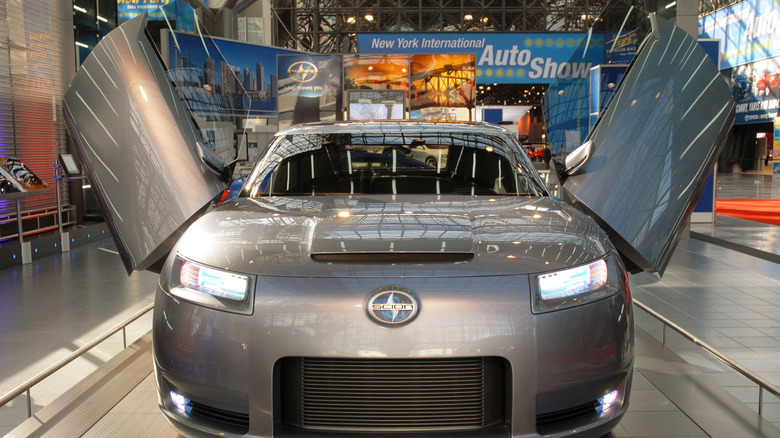Butterfly Vs. Scissor Doors: What's The Difference Between Them?
Sports cars and other high-performance vehicles are typically designed with two key factors in mind: Some impressive vital statistics on paper, and the stylish aesthetics to match. Such vehicles will often boast unique aesthetic touches that more conventional everyday models will lack. For instance, lots of us will be used to swinging our way in and out of standard-issue car doors that open outwards. Functional, yes, but generally not stylish or especially interesting. Some models, however, opt for something with much more wow factor, such as butterfly doors or scissor doors. There's something wonderfully futuristic about such doors, as though the occupants are emerging from a sleek Star Wars spaceship. To the untrained eye, it might be quite easy to mistake one type for the other, but there's more of a difference between scissor and butterfly doors than you might think.
Conventional car doors simply open outwards, and sometimes deceptively widely so. This can restrict the driver or passenger's exit from or passage into the vehicle, should they be in an unfavorable position in an emergency or should fellow drivers park too close in a busy lot. Both scissor and butterfly doors can be less vulnerable to this sort of issue because they open primarily vertically. The difference is that scissor doors are generally designed to simply open directly upwards, while butterfly doors 'unfurl,' both outwards and upwards. As such, "Automotive A-Z: Lane's Complete Dictionary Of Automotive Terms" notes that they are "hinged at the front edge behind the front wheel," and describes them as "a cross between a conventional door and a scissor door."
The emergence and functionality of butterfly doors
As with any stylish innovation, it took a notable model to be the first commercial car to sport butterfly doors. This distinction belongs to the Alfa Romeo 33 Stradale, created in 1967. Franco Scaglione, designing this marvelous machine, gave it some truly beautiful curves and a V8 2.0 liter, offering 230 horsepower. The 33 Stradale was revived with a spiritual successor, created in super limited quantities of (fittingly) 33 and sporting a price tag upwards of $1 million. The first was delivered in December 2024, and they all feature some of the elements that defined the original. Those butterfly doors are the most prominent among them, and according to Alfa Romeo, they help mark the car out as "the epitome of Necessary Beauty."
This idea of combining form and function has always been a watchword of the Italian company, and the smooth action of a set of butterfly doors is quite an effective way to sum it up: They're a real focal point and have a luxurious air, but perhaps not in a frivolous way. They have a practical purpose, too (the whole being able to exit the car in tight spaces thing), beyond the fact that cars with butterfly doors look very cool. The practicality perhaps isn't as dramatic as with the also-very-cool gull-wing doors, but a unique touch nonetheless.
The emergence and functionality of scissor doors
Where butterfly doors have a fluid, outwards-and-upwards motion reminiscent of the wings of the insect they're named for, scissor doors are not designed to be so graceful. Interestingly, they made their debut just a year after butterfly doors, this time equipped on the 1968 Alfa Romeo Carabo. The iconic Italian brand, then, is responsible for both of these fascinating systems, with design company Bertone developing the Carabo. In September 2024, Bertone took to Instagram to reminisce about the model and its doors, declaring that "What began as a practical solution for a sleek, wedge-shaped concept car soon became a game-changer in automotive design," and that "the Carabo wasn't merely ahead of its time — it revolutionized how we think about car doors." The primary difference between the two systems is that scissor doors strictly operate vertically.
They have become popular with certain brands, which has led to scissor doors' nickname of Lamborghini doors. In fact, per Justia Trademarks, the brand has a trademark on its scissor doors. It states, "the mark consists of the unique motion in which the door of a vehicle is opened. The doors move parallel to the body of the vehicle but are gradually raised above the vehicle to a parallel position." As with butterfly doors, the exact functionality and practicality of this style of door will depend on the vehicle and the current situation the vehicle finds itself in. One thing's for sure, though: both styles are unique enough to attract a lot of attention wherever they go. Scissor doors were even seen on an SUV, in the shape of the concept vehicle Ranger Stormer.


